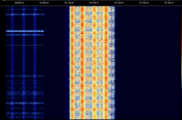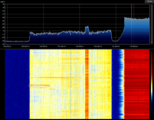NB-IOT
 | |
|---|---|
| Frequencies | 700 MHz,850 MHz,900 MHz,1800 MHz,1900 MHz |
| Frequency Range | 700 MHz - 1900 MHz |
| Mode | AM |
| Modulation | QPSK |
| ACF | — |
| Emission Designator | — |
| Bandwidth | 200 kHz |
| Location | Worldwide |
| Short Description | Narrowband Internet of Things (NB-IoT) is a Low Power Wide Area Network (LPWAN) radio technology standard developed by 3GPP to enable a wide range of cellular devices and services. |
| I/Q Raw Recording | Download file |
| Audio Sample | |
Narrowband Internet of Things (NB-IoTInternet of Things) is a Low Power Wide Area Network (LPWAN) radio technology standard developed by 3GPP to enable a wide range of cellular devices and services. The specification was frozen in 3GPP Release 13 (LTE Advanced Pro), in June 2016. Other 3GPP IoTInternet of Things technologies include eMTC (enhanced Machine-Type Communication) and EC-GSM-IoTInternet of Things
NB-IoTInternet of Things focuses specifically on indoor coverage, low cost, long battery life, and high connection density. NB-IoTInternet of Things uses a subset of the LTE standard, but limits the bandwidth to a single narrow-band of 200kHz. It uses OFDMOrthogonal Frequency-Division Multiplexing modulation for downlink communication and SC-FDMAFrequency Division Multiple Access for uplink communications.
There are three primary configurations in which NB-IoTInternet of Things can be deployed: inband, guardband, and standalone. In the inband configuration, NB-IoTInternet of Things is located within the LTE carrier, utilizing a single resource block. Alternatively, NB-IoTInternet of Things can be deployed in the guardband configuration, where it is situated between or aside LTE carriers. Finally, NB-IoTInternet of Things can also be deployed in a standalone operation, where it is located in a frequency band without any LTE carriers, such as near GSM carriers.
In March 2019, the Global Mobile Suppliers Association announced that over 100 operators have deployed/launched either NB-IoTInternet of Things or LTE-M networks. This number had risen to 142 deployed/launched networks by September 2019.

